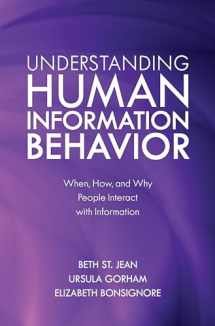
Understanding Human Information Behavior: When, How, and Why People Interact with Information
Book details
Summary
Description
Review
Extremely accessible, comprehensive, and useful, Understanding Human Information Behavior: When, How, and Why People Interact with Information discusses the relevance and significance of its subject to our work and everyday life and is well-positioned to empower students to become helpful information and technology professionals.
-- Yan Zhang, associate professor, School of Information, The University of Texas at Austin
This comprehensive text is the ideal resource for teaching human information behavior to undergraduate students. The text is organized in a thoughtful way to address all the most important aspects in an easy to digest manner, with the latter part of the book focusing on key areas of study within the information behavior field. The real world examples included in the text will appeal to undergraduate students and help them connect to what information behavior looks like in practice. The authors write in a winningly approachable style that will help students connect with the key concepts. I particularly like the inclusion of Discussion Questions which can be used by instructors as either homework or in class discussion points to foster a rich dialogue about each of the chapters. Applicable research studies are introduced in the text in an approachable way which will facilitate undergraduate engagement with the ongoing work in the discipline. The acronyms list and glossary at the back of the book are two additional, helpful resources for undergraduates to get caught up to speed on the most important topics under the umbrella of human information behavior.
-- Emily Vardell, PhD , assistant professor, School of Library and Information Management, Emporia State University
This introductory textbook aims to provide undergraduate students in information science and related disciplines with an applied grounding in information behavior. The book’s primary focus is to provide explicit links between information behavior and the careers that students will pursue within the information professions. With a deeper understanding of information behavior, students will be better equipped to address the many types of barriers that frequently prevent people from effectively and efficiently accessing, understanding, managing, and/or using the information they need in the “real world.”
The first six chapters of the book provide students with the fundamental building blocks of information behavior, introduce them to important related concepts, and provide a deep dive into information literacy, digital literacy, the digital divide and digital inclusion.
Chapters 7 through 12 introduce students to the scholarly communication system, providing guidance on how to find, read, and critically evaluate information behavior studies. Also explored in these chapters are the various methods used to investigate and understand people’s information behaviors. Topics covered include research design, research methods, research ethics, user needs assessment, and human-computer interaction and associated design methods. This part of the book also covers some of the major information behavior models and theories that have been developed to describe, predict, and/or explain people’s information behaviors.
In chapters 13 through 16, the authors provide an in-depth look into their own information behavior research areas, including consumer health information behavior and health justice; youth information behavior; legal information behavior and access to justice; and information behavior in libraries.
In the final chapter, students are first introduced to a wide range of careers within the information professions and then taken along on a deep dive into 10 specific jobs, with a special focus on the thread of information behavior that pervades the roles and responsibilities commonly associated with these positions.
Each chapter begins with one or more scenarios illustrating concepts covered in the chapter and ends with d


We would LOVE it if you could help us and other readers by reviewing the book
Book review



